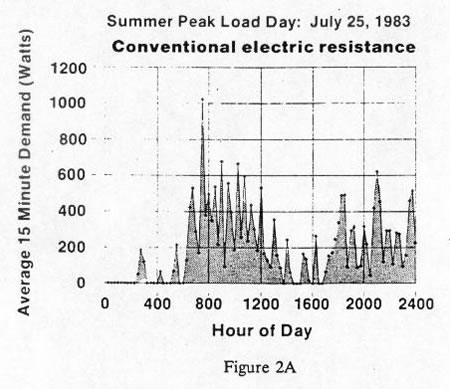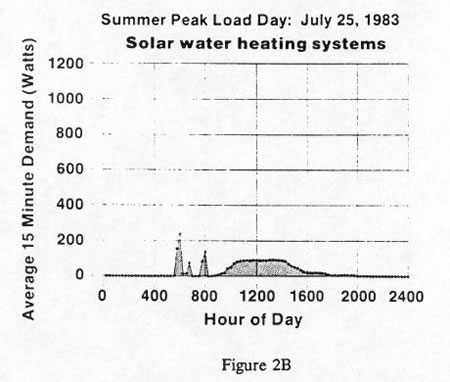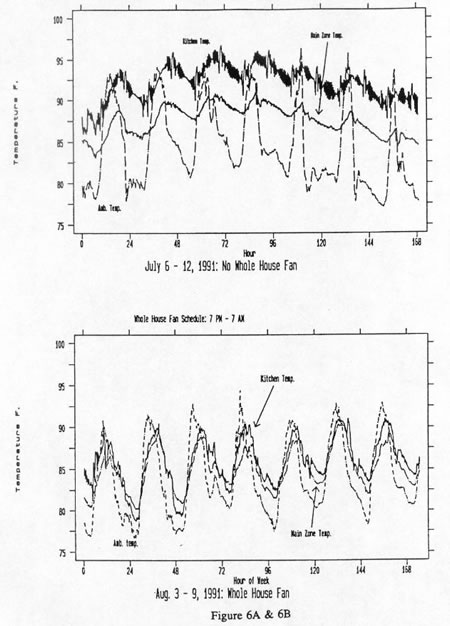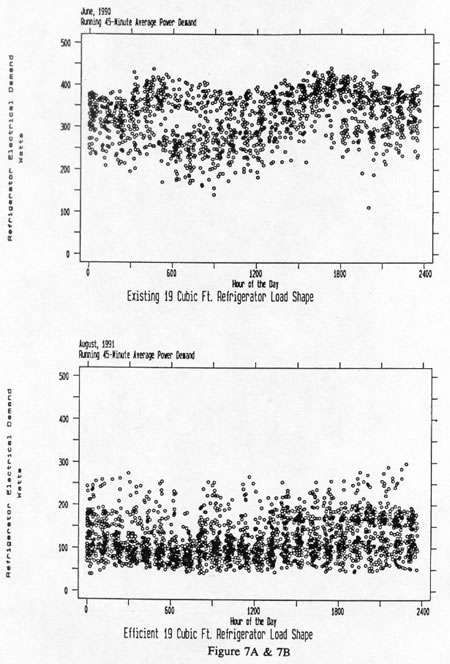
Reference Publication: Parker, D., Fairey, P., McCluney, R., Gueymard, C., Stedman, T., McIlvaine, J., "Rebuilding For Efficiency: Improving the Energy Use of Reconstructed Residences in South Florida", Prepared for U.S. Department of Energy, Florida Energy Office, and Florida Power & Light Company, FSEC-CR-562-92, December 1992. Disclaimer: The views and opinions expressed in this article are solely those of the authors and are not intended to represent the views and opinions of the Florida Solar Energy Center. |
REBUILDING
FOR EFFICIENCY:
Improving the Energy Use of Reconstructed
Residences in South Florida
Appendix A
Monitored Residential Building Energy Use in Florida
Monitored Residential Building Energy Use in Florida:
Implications for Building Efficiency Improvement in Hot-Humid Climates
Danny S. Parker
Florida Solar Energy Center
300 State Road 401
Cape Canaveral, Florida, U.S.A. 32920
Abstract
Incorporating energy efficiency improvements in residential buildings in hot-humid climates is considerably more challenging than with buildings in temperate regions. There are several reasons:
- Experience with efficiency improvements is significantly less in
cooling climates.
- The mechanisms governing the need for cooling are complex, including
temperature difference, solar flux, radiative heat transfer and humidity.
- Occupant related variation is much greater for cooling due to ventilation
behavior.
- Simulation models for prediction of cooling loads have proven to be
less reliable.
- The magnitude of domestic water heating and appliance loads are not well documented for hot climates.
As a result of these problems, it is desirable to use measured data to determine the magnitude of cooling loads and the performance of efficiency improvements. This survey paper examines various sources of monitored data from Florida’s sub-tropical climate. This is intended to help identify factors which may be important to efficiency improvements in hot climates where the electrical demand from air conditioning is increasing rapidly.
Keywords: Residential, Electrical Use, Cooling, Hot-Humid Climates, Monitored Data
Thermal Performance Monitoring of a Townhouse
An energy efficient residential townhouse in Cocoa, Florida was intensely monitored from 1983- 1986 [1]. Analysis of the data taken from the townhouses revealed two major influences on cooling which are commonly ignored. The tracer gas measured air infiltration rate of the townhouse was shown to increase dramatically when the air handler was operating. The air change rate (ACH) increased from 0.11 ACH with the air handle off to 0.52 ACH with the fan on. This discovery has lead to additional studies of this phenomenon.
Results also demonstrated that moisture adsorption into house furnishings may be a significant source of air conditioner latent load. A series of experiments were performed in which the townhouse was air conditioned during the day and ventilated at night. The level of interior furnishings was varied from none at all to a heavy level of interior furniture, full carpet and other furnishings. At a 25.6 °C cooling set point the amount of measured condensate removed by the air conditioner increased from 6.8 liters per day with no furnishings to 26.2 liters per day with heavy furnishings. This occurred because moisture was absorbed by the furnishings during the nighttime ventilation to be later removed by the air conditioner during daytime hours. As would be expected, air conditioner power also increased by approximately 21 % per day from the increased latent load.
Measured Electrical End-Use Data and Retrofit Savings
Monitored electrical end-use data from 25 single family homes in the Palm Beach area has been analyzed [2,3]. The 25 houses had a variety of retrofits performed prior to their second year of monitoring in 1982. Table 1 summarizes the end uses of electricity in the first year of the study:
Table 1
End-Uses of Electricity in 25 Palm Beach Homes
End Use |
Annual kWh |
Standard Deviation |
Percent of Total |
| Cooling | 8,282 |
5,485 |
32% |
| Heating | 2,740 |
1,866 |
10% |
| Hot Water | 3,606 |
1,477 |
14% |
| Refrigerator | 3,733 |
1,947 |
14% |
| Pool Pump (13) | 2,967 |
884 |
11% |
| Other | 4,899 |
2,511 |
19% |
| Total | 26,227 |
10,248 |
100% |
Analysis of the data showed wide variation in cooling energy use, mainly due to differences in natural ventilation during the cooling season. Some occupants mechanically conditioned their homes year round, while another extreme used natural ventilation, often with ceiling fans, to avoid air conditioning throughout the summer. As a result, cooling electhcal consumption varied 106:1 even when normalized by floor area. Figure 1 shows how the pre-retrofit consumption related to building floor area. Houses with extensive shading from trees used 34% less air conditioning electricity. This corroborates findings by another monitoring study conducted on a landscaped mobile home in South Florida [4].

The houses received a variety of ret.rofits intended to reduce cooling energy use. These included 20 new high efficiency air conditioning systems, 20 ceiling insulation upgrades, 26 ceiling fans, window tinting, duct system sealing and zoned air distribution systems. Post retrofit cooling consumption dropped to 5,320 kWh-- an average annual savings of 35%. Analysis revealed the most successful retrofits included high efficiency air conditioners, repair of duct systems and upgrades to ceiling insulation.
Of 21 water heating systems replaced, 19 received solar hot water systems
and two had desuperheater units installed. A total of 20 low flow shower
heads were provided, although three homeowners did not like the shower
quality and replaced the units. The solar hot water systems were measured
to provide 87% of the annual hot water use for a savings of 3,302 kWh.
The two de-superheater systems, which provide hot water as a by-product
of air conditioning operation, were found to supply a annual savings of
34% or 1,700 kWh although one of the systems was poorly matched to its
load. Sample size was not adequate to determine the savings of the low
flow shower heads.
Refrigeration and appliances comprised a surprisingly large fraction
of electrical demand in the group of houses-- fully a third of overall
consumption. A total of 18 less efficient refrigerators were replaced,
resulting in an average 49% reduction in refrigeration electrical use
(2,164 kWh). These retrofits were extremely cost effective, although monitoring
did show that the refrigerators used approximately 20% more electricity
than indicated by their Energy Guide label. Presumably, this was due to
the higher temperature conditions in Florida relative to that assumed
in the test procedure. These findings may be particularly important since
the saturation of residential refrigeration is greater than unity in most
parts of the United States.
Pool pumps, which consumed nearly 3,000 kWh in the 13 houses which
had them, were run an average of eight hours per day. Two of the pool
pumps were replaced with high efficiency models resulting in 30% lower
average second year consumption. The average summer diversified coincident
peak demand for pumping is at least 0.3 kW for homes with pool pumps with
this level of run-time. In one case, a sub-metered electrically heated
spa was shown to use over 3,000 kWh annually. On average, the combined
retrofits reduced overall electricity use by 30%. This represented an
average savings of over 7,850 kWh per year.
Measured Performance of Water Heating Systems
The electrical demand in 80 houses using four different hot water systems has been investigated. Twenty systems of each type were monitored from 1982 - 1984 in locations in South, Central and North Florida: conventional electric resistance, heat pump water heaters, de-superheater heat recovery units and solar hot water heaters [5]. Data was taken at 15-minute intervals so that time-of-day electrical demand data was available. Average annual hot water electricity consumption for conventional electric resistance systems was 3,030 kWh with a measured efficiency of 82%. Each conventional electric resistance heater was found to add an average of 0.3 kW to coincident electric demand form 5 - 6 PM on peak summer days. Solar systems reduced coincident summer peak demands by at least 0.2 kW and provided approximately 70% of annual hot water needs with a total electrical demand of only 980 kWh. Figure 2A and 2B contrasts the peak summer day aggregate load shape of the two system types which evidence rather dramatic differences. De-superheater systems provided useful reductions to peak summertime demand, but only marginally better performance than resistance systems for overall annual energy use. Heat pump water heaters performed with an annual efficiency of 153%, but only provided modest reductions to summer coincident peak demand.


Statistical Analysis of Matched Survey and Utility
Data
Utility data has been obtained from 384 attached and detached
dwelling in Central Florida which had an extensive survey administered
[6]. The survey results were statistically compared to the utility records.
Overall electrical use in residential buildings, which varied from 2,584 to
50,142 kWh/year, was found to be strongly related to building floor area.
Attached dwellings appeared to be more efficient in their energy utilization
as depicted in Figure 3.

A large factor in the variation of annual electricity use was found to be the number of months per year that occupants reported they ventilated their home. Each month of reported ventilation was shown to reduce annual electrical use by 388 kWh. Each degree higher (°C) which occupants reported they set their air conditioner thermostat corresponded to a 756 kWh reduction in annual electricity use. Dwellings with de-superheater systems used 3,087 kWh less than houses without these systems. Homes which used electricity to heated spas or pools used 6,841 additional kWh per year than did the rest of the sample. Each hour per day that occupants reported they ran their pool pump increased annual electrical consumption by 755 kWh. Other factors which were found to be significant in terms of annual electrical consumption were heated water beds, electric dryer use and whether there were children in the household.
Duct Leakage Study
An investigation of air distribution system leakage in 160
houses in Central Florida was performed in the summer of 1990 [71.
The study examined cooling energy use in a subset of 46 houses which
had the duct systems repaired at mid-cooling season. The study found
that
13% of the overall house leakage was located in the duct system. However,
the leakage area within ducts are under considerable pressure when the
air handler was operating. This caused the tracer gas tested average building
air change rate to increase from 0.28 to 0.91 ACH when the air conditioner
was operating-- over a three fold increase. Return leaks were often found
to pull make-up air from hot attic or garage spaces. The study determined
that houses with attic mounted air handlers used 30% more air conditioning
energy (49.9 kWh/Day) than those with air handlers in other location (38.4 kWh/Day). In
the repair at mid-summer, an average of 70% of the discovered duct leakage
was sealed. Prior to repair the houses used an average of 41.3 kWh/day
for cooling. Repairs resulted in a 17.2% decrease in air conditioning
electrical consumption. As expected, savings were highest for houses with
the air handler located in the attic. Figure 4 shows the effect of duct
system repair on the air conditioning electrical demand for one of these
houses.

Detailed Monitoring of a Florida Residence
Detailed monitoring of a single Central Florida house has been conducted
over the last year [8). The data has revealed that duct repair decreased
air conditioning consumption by 19%, with much of the savings occurring
during the afternoon hours. Research results also showed that the daily
air conditioning demand of the house was strongly linked to the temperature
difference between the house interior and the garage where the air handler
was located. Figure 5 shows the 15-minute air conditioning
demand load shape, both before and after repair on two hot days with similar
temperatures.

Our data collection also revealed that the house’s concrete block construction moderated daytime interior temperatures during natural ventilation, but that the ambient temperature (amb) fell well below the hot interior temperatures at night. This is potentially important in hot climates due to the dominance of the use of concrete in new residential construction in hot climates. A week long temperature profile in Figure 6A when naturally ventilating shows the problem. During last summer, a whole house fan was installed to measure the improvement in nighttime interior comfort [9]. Figure 6B shows the result: the operating whole house fan dramatically increases comfort during nighttime hours even during the hottest part of summer. The data also indicated that the interior kitchen temperatures were typically warmest and the best potential site from which a whole house fan could draw its ventilation air. Perhaps most importantly, the measured electrical consumption of the whole house fan (3.2 kWh/day) was less than one tenth of that used on average during the previous summer (36 kWh/day).

Refrigeration electricity consumption is also being measured.
We conducted a case study of the potential of retrofitting of an existing
refrigerator with an energy efficient model to alter utility load shape.
Consumption was metered for an entire year from June, 1990 to June,
1991 at a fifteen minute resolution. Both kitchen, refrigerator and
freezer temperatures were collected as well as recorded door openings.
The original refrigerator, which has been in service for approximately
15 years, is similar to other units which are soon to be replaced. The
unit is a 19.2 cubic foot frost-free Sears Coldspot 106-762911 refrigerator-freezer
with an automatic ice maker. Monitoring has shown utility peak hour
(5 - 6 PM) electrical demand to average approximately 303 W with annual
consumption of about 2,000 kWh-- a very substantial end-use of electricity
in the home. The existing refrigerator was replaced in July, 1991 with
the most energy efficient model of its size possessing the consumer
desirable amenities (automatic ice- maker, automatic defrost), a 1991
Frigidaire FPES19TIP. This model has a DOE estimated annual energy use
of 760 kWh.
Figure 7A depicts the electrical demand of the original refrigerator
over the month of June, 1990. Even with the scatter, a time-of-day use
pattern for the refrigerator is apparent; electrical demand is highest
at 8 PM after dinner preparation. Figure 7B plots the load shape for
the first month of data collected on the more efficient refrigerator.
The average electrical demand is reduced by more than half (287 vs.
122 Watts), although the newer refrigerator appears to use more electricity
(— 300 kWh/year) than the DOE test predicts. Regardless, with
over five million refrigerators in Florida, substitution with more efficient
units represents a major opportunity for state-wide utility demand side
management.

Research on Roof Thermal Performance
Attic thermal performance is critical in cooling dominated
climates since it affects heat gain across the ceiling surface. Control
of attic temperatures is doubly important if air distribution ducts
are located within this space. Previous research at FSEC has proven
that roof mounted radiant barriers can reduce ceiling heat flux by
30 - 50% with annual cooling electricity savings of 7 - 10% [10]. Reductions
to peak are generally higher as shown in Figure 8, a comparison of
the air conditioning load of two unoccupied frame houses in Gainesville,
Florida which were monitored side-by-side with and without a radiant
barrier.

Recent research at FSEC has focused on the influence of roof material on thermal performance. Six small roof models have been constructed to evaluate the resistance to heat gain of various types and colors of roofing materials [11]. Test cases have included black asphalt shingles, a white asphalt shingle roof with a reflective ceramic coating and a series of red tile configurations. Tile roofing sections included red concrete tile on single battens, red concrete tile on single battens with a radiant barrier, red concrete tile on double battens, and red clay tiles with a radiant barrier. Single batten (sb) refers to conventional installation of concrete tiles on plywood decking. Double batten (db) refers to two rows of battens which provides superior ventilation under the tiles. The radiant barrier (rb) cases had a low-emittance foil material glued to the underside of the tiles.

As shown in Figure 9, the performance of all the tile roofs is superior in limiting heat gain to the dark asphalt shingled model. As expected, the ventilated tiles roofs perform better, as does the addition of a radiant barrier to the tile underside. However, the shingled roof with the white reflective coating performed best of all with deck temperatures averaging no more than 1.0 °C higher than ambient. It is noteworthy, however, that the performance of the white asphalt shingle without the coating was only marginally better than the black shingled roof and inferior to all the tile roof types.
Conclusions
Examination of the results from the various described monitoring
studies in Florida indicates that unique solutions are required to improve
residential energy efficiency in hot and humid climates. Florida residential
buildings are dominated by cooling needs. However, cooling energy demand
is strongly influenced by many complex interacting factors such as temperature
difference, solar flux, radiative heat transfer, humidity levels, internal
appliance loads and ventilation behavior. Measured data showed that
commonly advocated retrofits, such as ceiling insulation and high- efficiency
air conditioners, provided expected savings.
Other considerations play a role in determining energy efficiency
in Florida homes which are much less a consideration in northern climates.
Moisture adsorption of furnishing may interact with air conditioner
latent loads. Recent data suggests that forced air distribution system
leakage, duct heat transfer and air handler location are critical factors
in effective air conditioner efficiency. Current research indicates
that roofing material characteristics can play an important role in
determining attic thermal performance. Radiant barriers, tile roofs
and elastomeric white coatings for shingles appear to provide performance
advantages. Landscape shading may also provide significant cooling energy
savings although, as of yet, its effect on air conditioner load shape
is unknown.
Hot water electrical use is generally lower in warmer climates due
to the higher inlet water temperatures. Average annual electrical use
was only about 3,000 kWh. Electric hot water systems were found to add
relatively modest amount of demand to the summer peak (0.3 kW). However,
measured results show that solar hot water heater systems can avoid
70 - 90% of
annual and summer peak electrical demand. A similar reduction can
be achieved by desuperheater systems during the air conditioning season.
Refrigeration was found to be a relatively large fraction of overall
electrical use in Florida houses (14%). Older refrigerators can use
over 2,000 kWh per year and can add 0.3 kWh to the peak summer electrical
demand. More efficient newer models can reduce this electrical use by
more than 50%. Replacement of aging inefficient units represents
a large DSM opportunity in hot climates since the saturation of refrigeration
is very high, and their presence on the house interior faces the air
conditioner with additional internal heat gains.
Pool electrical use can be significant in hot climates. Analysis
suggest that electrical loads from pumping and heating of swimming pools
and spas can be large in magnitude. Pool pump and heating timers, which
lock-out certain utility defined peak hours, may present a very cost
effective load shifting strategy.
References
-
Cromer, C.J. and Cummings, LB., Thermal Performance Field Monitoring of Various Conservation Construction Techniques, Florida Solar Energy Center, FSEC-CR-172-87, Cape Canaveral, FL, May, 1987.
-
Messenger, R., Hays, S., Duyar, A., Trivoli, G., Vincent, 3., Guttmann, M., Robinsion, 3., Litschauer, B., Jarvis, 3. and Pages, E., Maximally Cost Effective Residential Retrofit Demonstration Program, FAU, Boca Raton, FL, 1982.
-
Parker, D.S., “Monitored Residential Space Cooling Electricity Consumption in A Hot- Humid Climate: Magnitude, Variation and Reduction from Retrofits,” Proceedings of the 1990 Summer Study on Energy Efficiency in Buildings, American Council for an Energy Efficient Economy, Asilomar, CA., Vol.9,p.253, 1990.
-
Parker, J.H., “The Effectiveness of Vegetation on Residential Cooling,” Passive Solar Journal, Vol. 2, No. 2, American Solar Energy Society, Boulder, CC, 1982.
-
Merrigan, T. and Parker, D.S., “Electrical Use, Efficiency, and Peak Demand of Electric Resistance, Heat Pump, Desuperheater and Solar Hot Water Systems,” Proceedings of the 1990 Summer Study on Energy Efficiency in Buildings, American Council for an Energy Efficient Economy, Asilomar, CA, Vol.9,p.221, 1990.
-
Vieira, R.K. and Parker, D.S., Energy Use in Attached and Detached Residential Developments, Florida Solar Energy Center, FSEC-CR-381-91, Cape Canaveral, FL, January, 1991.
-
Cummings, J.B., Tooley, J.J. and Moyer. N., Investigation of Air Distribution System Leakage and its Impact in Central Florida Homes, Florida Solar Energy Center, FSECCR-397-91, Cape Canaveral, FL, January, 1991.
-
Parker, D.S., Monitored Energy Use Characteristics of Florida Residence, Florida Solar Energy Center, FSEC-RR-23-91, Cape Canaveral, FL, April, 1991.
-
Parker, D.S., “Florida Cooling, the Natural Way,” Home Energy, Vol. 8, No. 6, November/December, 1991, p. 32.
-
Fairey, P., Swami, M. and Beal, D., Radiant Barrier System Technology: Task 3 Report, Florida Solar Energy Center, FSEC-CR-211-88, Cape Canaveral, FL, April, 1988.
-
Chandra, S., “Retrofit Options for Residential Roofs: Preliminary Results and Recommended Research,” Florida Solar Energy Center, Cape Canaveral, FL, April, 1991.
